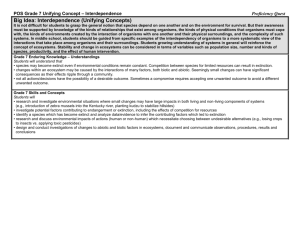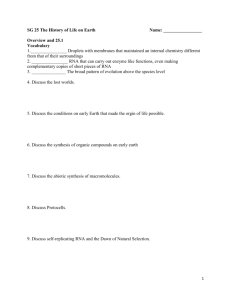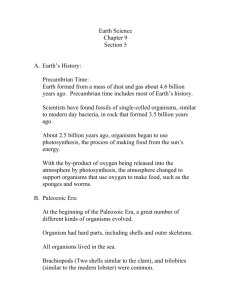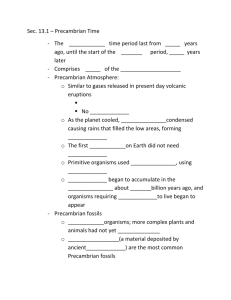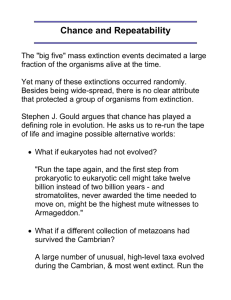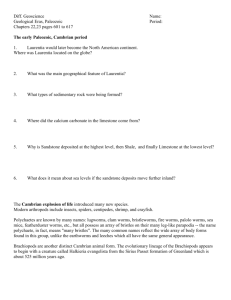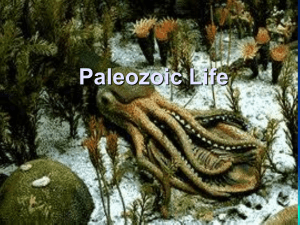Precambrian and Paleozoic Life
advertisement
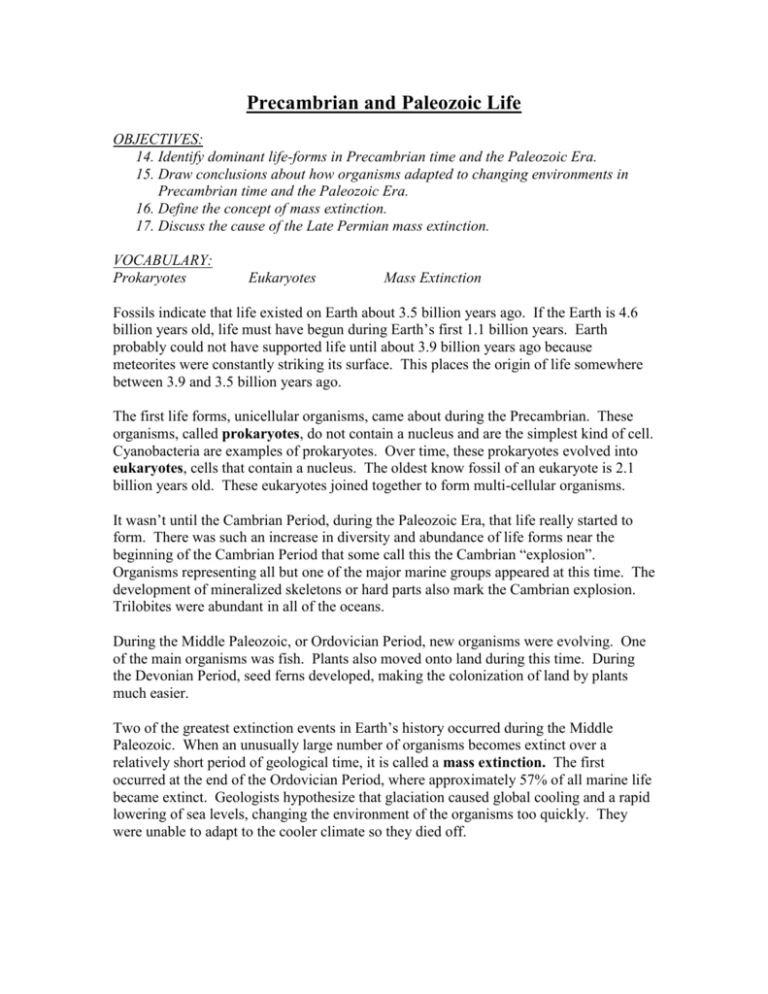
Precambrian and Paleozoic Life OBJECTIVES: 14. Identify dominant life-forms in Precambrian time and the Paleozoic Era. 15. Draw conclusions about how organisms adapted to changing environments in Precambrian time and the Paleozoic Era. 16. Define the concept of mass extinction. 17. Discuss the cause of the Late Permian mass extinction. VOCABULARY: Prokaryotes Eukaryotes Mass Extinction Fossils indicate that life existed on Earth about 3.5 billion years ago. If the Earth is 4.6 billion years old, life must have begun during Earth’s first 1.1 billion years. Earth probably could not have supported life until about 3.9 billion years ago because meteorites were constantly striking its surface. This places the origin of life somewhere between 3.9 and 3.5 billion years ago. The first life forms, unicellular organisms, came about during the Precambrian. These organisms, called prokaryotes, do not contain a nucleus and are the simplest kind of cell. Cyanobacteria are examples of prokaryotes. Over time, these prokaryotes evolved into eukaryotes, cells that contain a nucleus. The oldest know fossil of an eukaryote is 2.1 billion years old. These eukaryotes joined together to form multi-cellular organisms. It wasn’t until the Cambrian Period, during the Paleozoic Era, that life really started to form. There was such an increase in diversity and abundance of life forms near the beginning of the Cambrian Period that some call this the Cambrian “explosion”. Organisms representing all but one of the major marine groups appeared at this time. The development of mineralized skeletons or hard parts also mark the Cambrian explosion. Trilobites were abundant in all of the oceans. During the Middle Paleozoic, or Ordovician Period, new organisms were evolving. One of the main organisms was fish. Plants also moved onto land during this time. During the Devonian Period, seed ferns developed, making the colonization of land by plants much easier. Two of the greatest extinction events in Earth’s history occurred during the Middle Paleozoic. When an unusually large number of organisms becomes extinct over a relatively short period of geological time, it is called a mass extinction. The first occurred at the end of the Ordovician Period, where approximately 57% of all marine life became extinct. Geologists hypothesize that glaciation caused global cooling and a rapid lowering of sea levels, changing the environment of the organisms too quickly. They were unable to adapt to the cooler climate so they died off. A second mass extinction occurred during the Late Devonian Period where 50% of marine life was wiped out. Global cooling may have created an overturning of the ocean, where oxygen poor waters are brought to the surface and organisms have little or no oxygen to live on. The invertebrate marine organisms that flourished during the Middle Paleozoic continued to dominate the marine environment. Crinoids became dominant during the Mississippian Period, and they are still around today. Following the extinction of many fish during the Late Devonian, sharks and other ray-finned fish became more abundant. Lobe-finned fishes, such as the lung fish and coelacanths, became more abundant and some of them even made it onto land, giving rise to the amphibians. Ferns and insects dominated the land but the amphibians were the top carnivores. During the late Mississippian, reptiles developed and eventually replaced the amphibians as the top carnivores. What advantage did the reptiles have over the amphibians? The largest mass extinction in the history of life on Earth defines the end of the Paleozoic Era where 95% of all species, including trilobites, became extinct. This time it didn’t just affect marine life, but also land life. 65% of amphibians and reptiles died out, along with 30% of insects. Scientists aren’t too sure about what caused this extinction, but major marine regression, dropping of water levels and exposing the continental shelf, is one reason.



